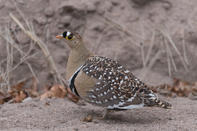
Name
Double-banded Sandgrouse - Pterocies bicinctus
Appearance
Double-banded sandgrouse generally have light brown plumage, with rows of white specks and some darker mottling. Males have a chestnut throat, with a black and white band across the chest, with black and white markings on their forehead. A small area of pale yellow skin surrounds the eyes, with the male having an orange beak.
Double-barred sandgrouse are around the same size as a pigeon at 25 cm in length, with females being slightly smaller than males. The female has a barred chest, that separates it from other sandgrouse found in the area.
Diet
The double-banded sandgrouse feeds exclusively on seeds.
Double-banded Sandgrouse Breeding
The double-banded sandgrouse is monogamous. Breeding season starts with the double-banded sandgrouse male doing a mating dance, where he walks around in circles with his head close to the ground and his tail raised upwards. Both parents will incubate their two or three eggs, that are laid in a shallow scrape or depression.
The chicks hatch at around 24 days and are precocial, but they are unable to fly for around one month from hatching, but are able to run with the parents. After around one month, the chicks grow adult feathers and are able to fly. Both parents care for the young.
Double-banded Sandgrouse Behaviour
As with all sandgrouse, the double-banded will carry water to its chicks by means of belly feathers. As the chicks cannot fly, the parents need to supply their chicks with moisture. After soaking his chest and belly feathers in water, the male will fly to the nest and chicks to let the chicks drink. This is also done by the female, but to a lesser extent, due to females not having the same amount of absorbent feathers as the males.
The double-banded sandgrouse drinks and collects water at dusk.
Threats
None.
Double-banded Sandgrouse Distribution and Habitat
The double-banded sandgrouse is found mostly in mopane woodlands, in arid or semi-arid areas. They are found in the Northern Cape, Northwest and Limpopo Provinces of South Africa. The double-banded sandgrouse is a near endemic.